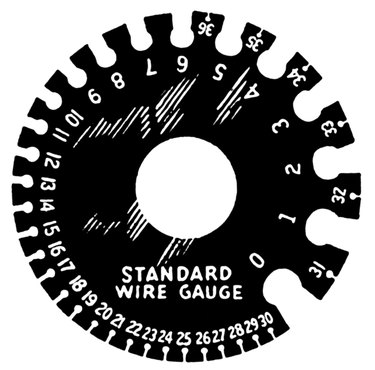
Wire is commonly sized in gauges, which increase in number while the size of the wire decreases. A 10-gauge wire is considerably larger than 20-gauge wire. The standard wire gauges for steel wire are different from the standard sizes for other types of wire, such as copper or aluminum. Wire used for carrying current follows one standard, while steel, iron and other wire types have different standards. Manufacturers use the U.S. Steel standard for steel wire, the American Wire Gauge standard for current-carrying wire and other standards for various metals used to make wire.
Gauge System of Sizing Wires
Video of the Day

Wire is manufactured by pulling a rod through consecutively smaller dies until it reaches the desired size. Prior to modern manufacturing methods, the number of dies a wire passed through before reaching its finished size became its gauge number. Thus, a gauge size of two had been pulled through two dies to reach the desired diameter. The same was true of six-gauge wire; six die passes produced six-gauge wire. Therefore, the smaller the wire, the higher the gauge number. Today, the required number of dies has been reduced by improved manufacturing, but the old system of gauges persists using the diameters standardized in the past.
Video of the Day
Various Metals and Standards
The American Wire Gauge (AWG) may be the most familiar gauging standard in use today. It refers primarily to the size of wires used for carrying electricity. Iron wire is based on the Birmingham Gauge. Tool-grade steel wire is sized according to the Stubs Gauge, which is used for making drill bits and other tools. Steel wire for other purposes is sized by the U.S. Steel Wire Gauge, which has had several names over the years. The Needle Wire Gauge is used to size needles and is based on the Birmingham standard. The Edison Electrical Light Co. based its gauge system on the cross-sectional area of the wire, an improvement even over the commonly accepted American Wire Gauge used today.
Electrical Wire Gauges
The amount of electricity a wire can carry is called its ampacity. The ampacity of a wire is based on its cross-sectional area and the type of insulation covering it. Insulation rated at a higher temperatures allows the wire to carry more current without catching fire. Typical insulation ratings by the National Electric Code are 60, 75 and 90 degrees Celsius. One-gauge wire is allowed to carry 110 amps with 60-degree insulation, and 150 amps with 90-degree insulation.
Music Wire Gauges
Music wires have their own gauge system and it varies by manufacturer, although all are very similar in size except for a few made in other countries. This specialized wire is sized to produce specific tones and sounds. Commonly referred to as piano wire, music wire is made from high-carbon steel, hardened to exacting standards. It has other uses besides musical instruments and is often used in the manufacture of fishing lures and other products.
Steel Wire Gauges
Steel wire is sized in gauges just as other metals for a wide variety of manufacturing purposes ranging from grocery store shopping carts to steel ropes and cables that support suspension bridges or lift heavy loads. Unlike many of the softer and lighter metals, steel wire is less forgiving, heavier and ultimately stronger than most other metal wires. The die drawings once used to produce a given thickness have changed, but the wire gauge sizes have not. Steel wire gauges range from size 7/0 (0.49 inch diameter) to 36 gauge, a mere 0.009 inches in diameter.
Stranded Wire Gauges
Stranded wire is made up of a number of smaller wires twisted or wound together. Solid and stranded wires of the same gauge are different diameters, with the stranded always being larger. Stranded wire gauge is determined by calculating the total cross-sectional area of the small wires used and comparing it to the same cross-sectional area of a solid wire.